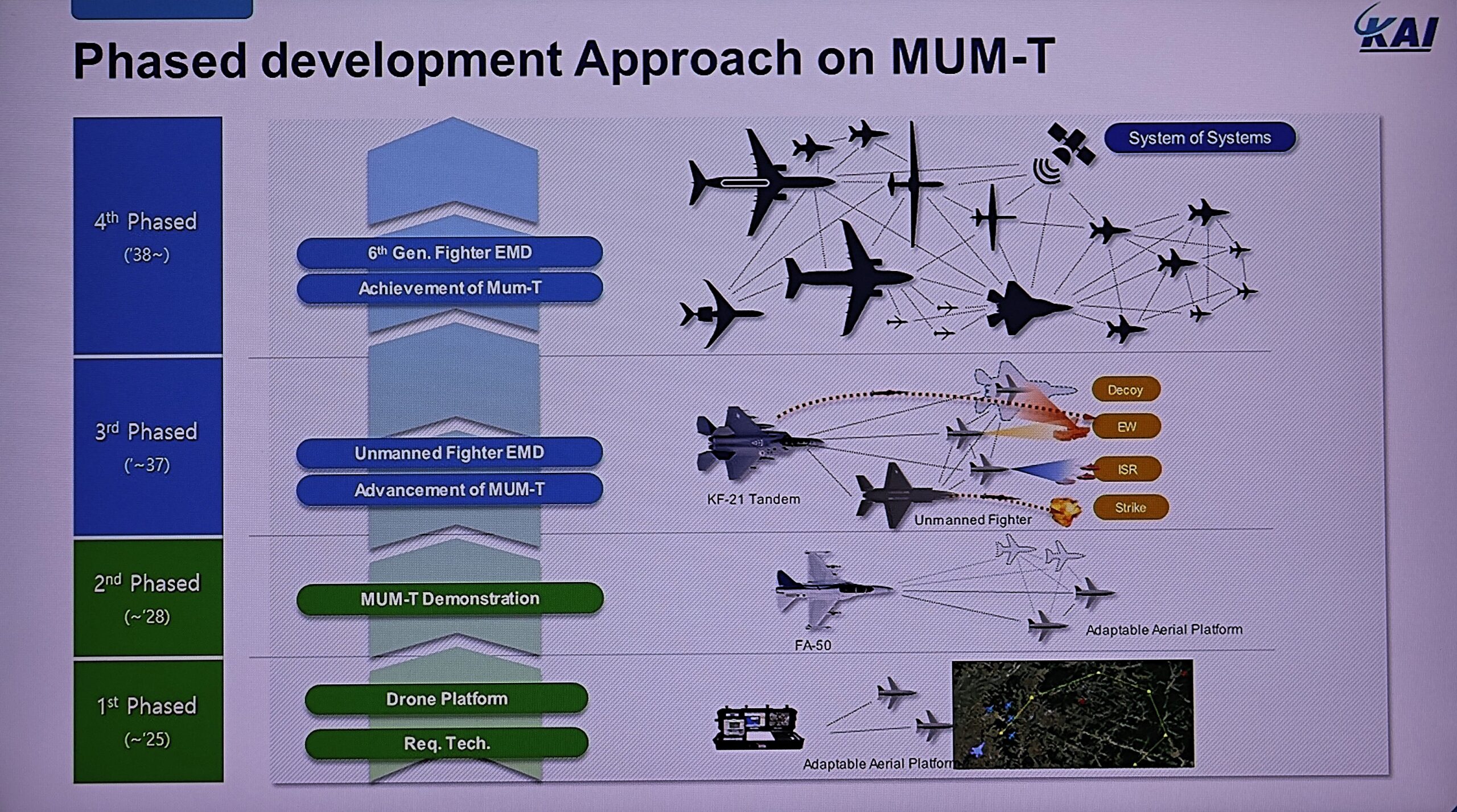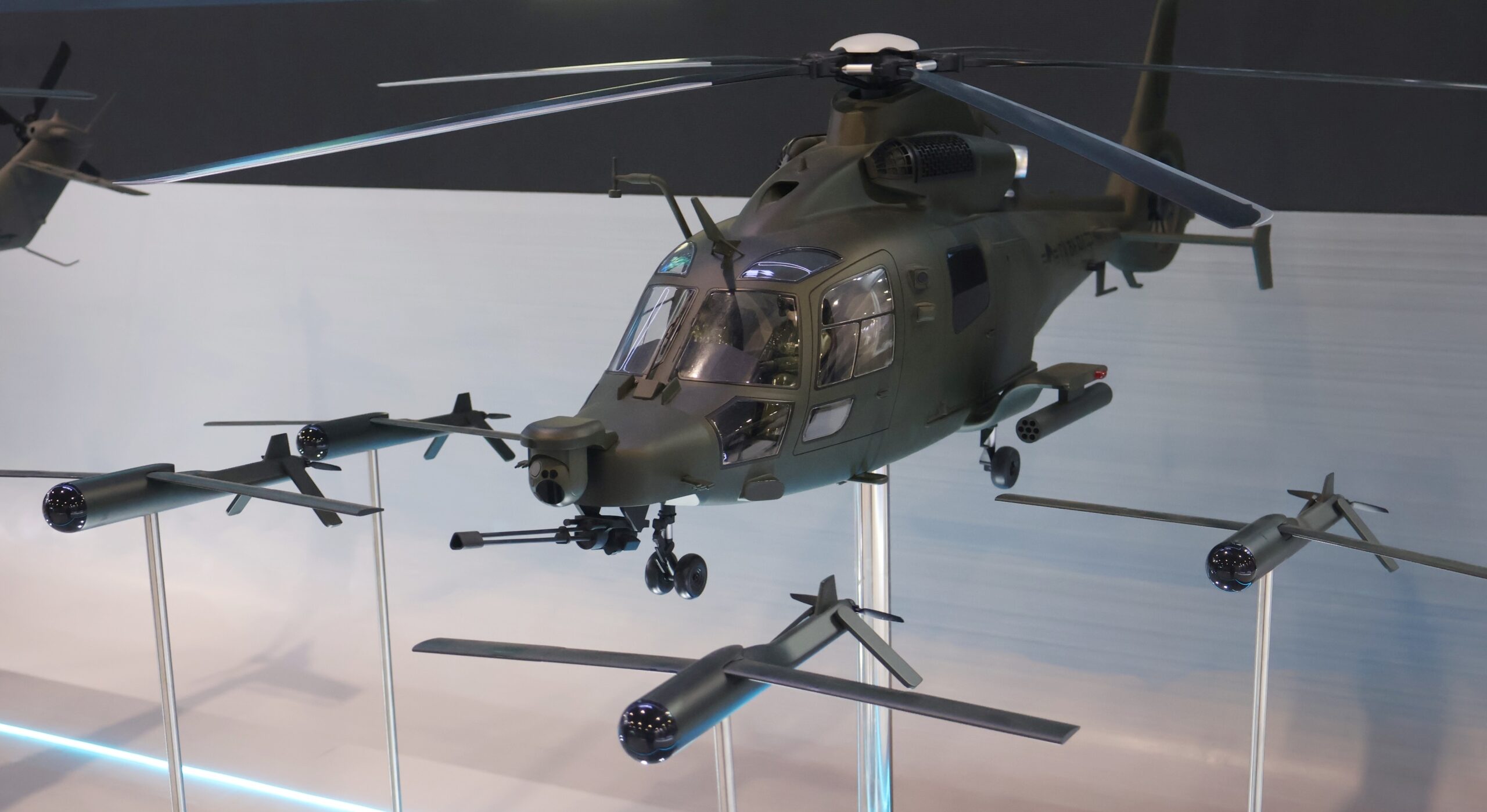Development of the KF-21 combat aircraft is going well, and Korea Aerospace Industries (KAI) is now exploring manned-unmanned teaming possibilities.
Korea Aerospace Industries (KAI) is making good progress on development of the KF-21 Boramae (Young Hawk) combat aircraft. Since the first flight in July 2022, six prototypes including two twin-seaters have logged nearly 800 test hours on a path towards 2,000 hours and initial production in 2026. Moreover, the company is already developing Manned-Unmanned Teaming (MUM-T) concepts, and showed its thinking in detail at the recent Singapore Airshow.
Key accomplishments last year were the first flights of the fourth, fifth and sixth prototypes in the first half of last year, and release and firing of the Diehl IRIS-T short-range and MBDA Meteor long-range air-to-air missiles (AAMs). The KF-21 also passed a provisional evaluation by the Defence Acquisition Programme Administration (DAPA), the Korean government agency that has overseen the $8 billion-plus development effort, which began in 2015.
KF-21 chief test pilot Lee Dongkyu told Asian Military Review in Singapore that the latest flight test achievements have been air refuelling trials with an Airbus A330MRTT of the Republic of Korea Air Force (ROKAF), and flight up to 70 degrees angle of attack (AoA).

The ROKAF plans to buy 120 KF-21s to replace its F-4s and F-5s. The first 40 will be to a Block 1 standard that offers air-to-air capability. Of particular note, Lee said that the complex integration of the Meteor is already 90 percent done, a figure that was confirmed by MBDA. The weapon will initially be carried on the four semi-recessed fuselage stations, while there are three stations under each wing to carry the IRIS-T and air-to-ground weapons plus targeting pods that will come with the Block 2 standard. These weapons could include MBDA’s SPEAR and Brimstone, after last November’s agreement between KAI and MBDA to explore their integration.
Lee said that the ultimate Block 3 standard will provide stealth characteristics. The ROKAF has described the KF-21 as a “4.5 generation” fighter, which suggests that it will not match the F-35 for low-observability. The service has ordered 60 F-35s, to operate alongside the KF-21s.
But according to KAI, the Boramae will offer ‘reduced observability’ from the start of production, thanks to an outer mold line that is aligned for stealth, and S-duct intakes for the twin GE F414 engines. Radar-absorbent foam and paint also feature in Block 1. Internal weapons carriage plus Radar-Absorbent Structure (RAS) and Material (RAM) will follow in Block 2, to confer “low observability”. Indeed, the RAM that is reportedly being developed for the KF-21 is a sealant type that degrades more slowly than existing treatments.
The Korean technology conglomerate Hanwha is a key subcontractor on the KF-21. It is providing the AESA radar, infra-red and electro-optic search and track systems, and some other avionics. Elta and Saab have supported the radar design. Hanwha is also manufacturing some parts for the F414 engines, and assembling them all in Korea. Another Korean avionics company, LIG Nex1, is providing electronic warfare systems. But there is also foreign content from Cobham, Martin-Baker, Meggitt and others.
KAI and other Korean companies have a 20 percent stake in the KF-21, but the Korean government is the main funder, with 60 percent. The other 20 percent is theoretically coming from the Indonesian state-owned aerospace company PTDI. It is supposed to acquire one of the prototypes before embarking on local production of 48 for the Indonesian air force.

But progress payments from Jakarta for the development phase soon fell behind schedule, and stopped completely in 2017. Some 100 engineers from Indonesia worked in KAI, but were withdrawn at the start of the pandemic in 2020. In late 2021 the agreement was renegotiated. Payments resumed in 2023, but to date, Indonesia has still only contributed just over $200 million to the project. A much smaller cohort of Indonesian engineers has returned to Korea.
In February this year, one of them was caught leaving the KAI factory with “several unauthorised USB sticks”, according to official investigators. In March, police raided the factory to secure the data on his work computer, and on that of another Indonesian engineer. They are both currently prohibited from leaving Korea.
On the KAI stand at the Singapore Airshow, models of the KF-21 and the company’s FA-50 light combat aircraft were shown in formation with medium-size unmanned aircraft described as “adaptable aerial platforms” (AAPs). A model of the KAI Light Attack Helicopter (LAH) was shown in formation with smaller UAS with wings that unfold after launch from the helicopter’s stub pylons.

In a slide presentation, the company presented concepts and schedules for its Manned-UnManned Teaming (MUM-T) developments. It says that a combination of high-capacity communications and artificial intelligence (AI) can make this a reality by the end of the decade.
KAI began R&D on its AAPs last year. They will initially be tasked for ISR or as decoys, flying under ground control by 2025. From 2025-2027 they hope to demonstrate two of them flying under the control of the backseat pilot in an FA-50. In a third phase from 2028, a larger unmanned combat air vehicle (UCAV) will be developed. It will be controlled from the back seat of a two-place KF-21. The UCAV will perform strike missions, but will also be able to control the smaller AAPs that will be further developed to include electronic warfare capability. Alternatively, the AAPs can be controlled directly from the KF-21.
One of the slides shows an operational concept, where a target is located within overlapping ground-based air defence systems (GBADs). The AAPs take the lead in entering the high-risk area, employing deception and electronic attack. The UCAVs follow, striking the GBADs. With the threat rings diminished or eliminated, the main target is exposed to a strike by the KF-21.
Does “Korean MUM-T” sound fanciful? One slide reveals that the groundwork has already been laid for the rotorcraft version of MUM-T. Since October 2012, DAPA has been funding an adaptation of the LAH to carry and control UAVs, as shown on the stand model. Work to develop the AI to reduce pilot workload has now begun.
by Chris Pocock













